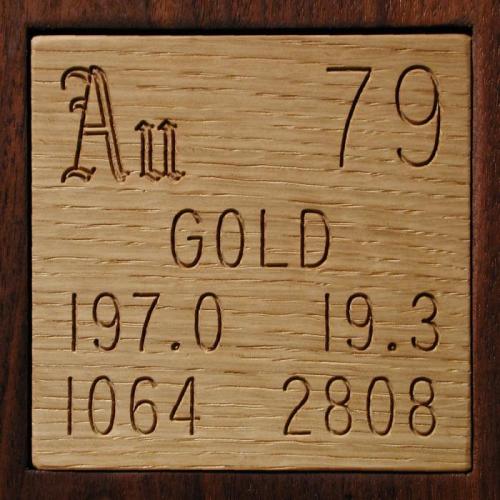  Three ounce bar. Three ounce bar.
Measured strictly by monetary value, the two most expensive samples in the periodic table are this bar of gold, and the ten gram ampule of scandium. Both are worth well over a thousand dollars, and both were donated (the scandium outright, this bar on a semi-permanent loan basis).
It's very gratifying to know that people think my periodic table is a worthy home for such valuable objects. I certainly never expected to get any significant number of donated elements, let alone truly valuable ones.
In the case of this gold bar, there's another factor: Its mystique. Of course, the first thing you notice about it is the weight. It's damn heavy. It's crudely made: This is not the product of an industrial gold refining operation. From the shape and markings, it's clear the bar was made by pouring molten gold into a rectangular groove in a course material, possibly sand. The bar tapers slightly, which means the mold was not level. It ends in a round bullnose, which means the gold cooled and solidified before reaching the end of the groove. That in turn means the gold was just barely molten, as if bringing it to the melting point required a long effort and it was poured just as soon as it could be. The other end has clearly been cut with a dull sheer or chisel (the metal is bunched up, indicating that the tool used to cut it was relatively thick, and pushed the metal back as it was going through).
All in all, it bears a striking resemblance to the tin bars I made by pouring molten tin into sand grooves. Whoever made the gold bar obviously spent a bit more time and care making the mold than I did, but not a whole lot more.
Analysis by x-ray fluorescence spectroscopy at the Center for Microanalysis of Materials, University of Illinois (partially supported by the U.S. Department of Energy under grant DEFG02-91-ER45439) indicates the following composition:
99.42% Gold
0.32% Copper
0.26% Silver
This is 24 caret pure gold, almost qualifying as .999 fine.
One could speculate endlessly about who, when, where, and why this bar was made. Was it a jeweler who was just consolidating scraps, with the intention of using a rolling mill to form the bar into the various bar and sheet stock he'd use to make jewelry out of? It's the right shape, but jewelry gold is never that pure (it's too soft in pure form).
Or was it a gold miner consolidating gold into easily cut bars for sale or trade? There are no stamps or assay marks, which means it was not made for resale by a foundry, large or small. But it could have been an individual miner.
Perhaps a thief or fence melted down stolen jewelry to disguise its identity. Maybe it was part of a nobleman's hoard, consolidated from taxes. There are so many possibilities, from the mundane to the exotic, that you can't help but speculate while holding it.
Sometimes it's more than a little creepy. If you look at it just right, it looks like a finger. A gold finger, thin, bony, and cruel. Other times it just looks like a working jeweler's blank, nothing sinister at all. But with gold, evil is never far away. Gold, literal or figurative, has been the focus of greed and injustice for longer than anyone can say. It may be disguised in the form of pretty jewelry that delights the eye, but melt it back down to a crude bar like this, and you reveal the truth: People lust after gold not because it is pretty, but because it is gold.
Source: George (not 007) Lazenby
Contributor: George (not 007) Lazenby
Acquired: 21 October, 2002
Price: Donated
Size: 3"
Purity: 99.42%
|
| 
|
|